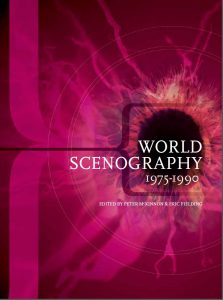Thanks to Travel and Training support from the Arts Council of Ireland, I was able to attend the Prague Quadrennial earlier this June. PQ is the world’s largest exhibition of design for performance that takes place in Prague every four years. In 2007 Ireland was represented officially for the first time, and as Exhibition Coordinator, I was lucky enough to get to go, also for the first time.

‘The Submission’ – Vladislav Nastavshev – Latvian national exhibit
A lot has changed in the intervening 12 years. The big, beautiful Výstaviště Palace, which was used as the exhibition space up to 2007, was badly damaged in a fire the following year. This forced the PQ to stretch across multiple venues in 2011, and even more so this year – insinuating itself into the daily life of the city centre for a couple of weeks. The tone of the exhibition has changed too. There is less of the stall-to-stall ‘best of’ of each country’s design, as national curators now tend towards focusing on specific designers or companies, or stand-alone (kinda) artistic installations – with very mixed results. This one by a Latvian designer was one of my favourites.

Detail from the Russian exhibit
Then again, I’ve always had an ambivalent feeling about the exhibition. I think it partly comes from how unevenly curated it can be – each country having a hugely varied capacity and budget for their exhibit. Each year I’ve come with high hopes and am often struck by the amount of work I really dislike, or consider bad design. It takes me a long time to root out things that I connect with aesthetically, and often that truffle hunt feels like too much effort. The exhibition is huge, and just navigating the city centre Prague mid-June tourist hordes is exhausting. That said, I know no other opportunity like it to see such a breadth of international design work, so I really shouldn’t grumble.
This year, for the first time, I signed up for two day-long workshops at DAMU, the Theatre faculty at the Academy of Performing Arts – partly to meet people at what can be a lonely event where you sometimes feel everyone else is having more fun that you. In one, a group of us spent a day building a giant two-storey Rube Goldberg machine, and in the other we worked with UK artist James Leadbitter aka the vacuum cleaner to design our ideal asylum, as part of his Madlove project. Highly recommended. Nothing like playing with ideas to cheer you up.

Idea of running up daily flags to tell the world how you feel

